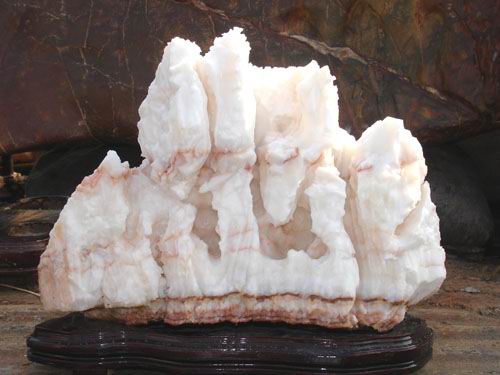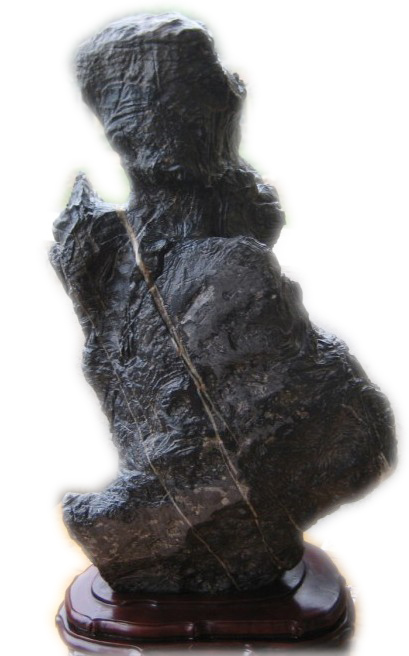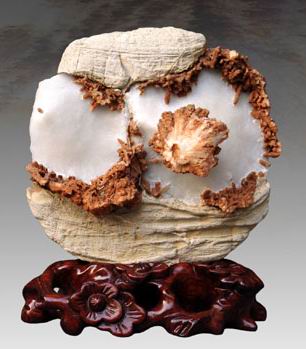Chinese Lingbi stone Photos & culture introduction.
3 posters
Page 1 of 1
 Chinese Lingbi stone Photos & culture introduction.
Chinese Lingbi stone Photos & culture introduction.
Long ago In the sinian period, lingbi county where lingbi stone was discovered once Flooded with sea water .in the same time, more over the algae grow and developed, it then formed into skerry and sedimentary rock, it is finally transformed into variety lingbi stones. Lingbi stone is smooth in textures, rich in assortment, gorgeous in colors and fantastic in shapes and it is quite hardness. Its shapes are wealthy, look like animals, landscapes, birds and ancient beast. With the value of collection and appreciation, many people look upon it as treasure.

Lingbi stone has been the “number one stone of china ”, and the first stone of the four Chinese famous stone, in the light of its exquisiteness and long history as well as its rich culture connotation, for that reason, there has been an unprecedented grand occasion of collecting and investing on lingbi stone, the lingbi village is also developed as the tourism spot and a new round of tourism upsurge in this village has aready started.

According to faithful history account, lingbi stone culture was originated in Song dynasty (960-1279) AD13th century, popularized in Ming dynasty and Qing dynasty, in the ancient world, the lingbi stone was deeply loved by emperors as well as scholars and poets, and is collected by the palace museum in Beijing, the stone was also stored in the museum of Britain. At present, in the mainland of china together with Hongkong, Taiwan and Macao, there are many fans of lingbi stone. Every year, numerous fairs for the stone are held both home and abroad, lingbi stone now is stepping into an unprecedented bloom age.

Every individual stone is different in unique figure, because it is the result of reactions chemically and physically after the billion of years, that is also why people cherish, appreciate and collection them because each of them is special, you can never find two same stones, and your imagination will endow the stones with wings, Lingbi stone is a masterpiece of nature, we can view it as poem, or view it as beautiful picture, you can find that every stone has a special beauty.
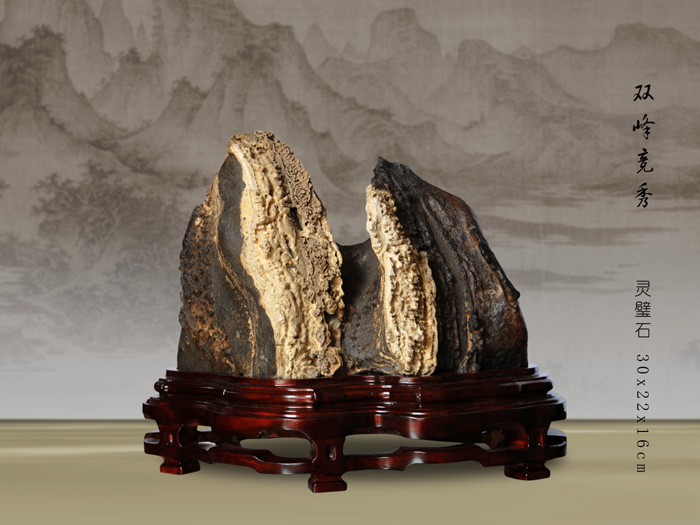

Lingbi stone has been the “number one stone of china ”, and the first stone of the four Chinese famous stone, in the light of its exquisiteness and long history as well as its rich culture connotation, for that reason, there has been an unprecedented grand occasion of collecting and investing on lingbi stone, the lingbi village is also developed as the tourism spot and a new round of tourism upsurge in this village has aready started.

According to faithful history account, lingbi stone culture was originated in Song dynasty (960-1279) AD13th century, popularized in Ming dynasty and Qing dynasty, in the ancient world, the lingbi stone was deeply loved by emperors as well as scholars and poets, and is collected by the palace museum in Beijing, the stone was also stored in the museum of Britain. At present, in the mainland of china together with Hongkong, Taiwan and Macao, there are many fans of lingbi stone. Every year, numerous fairs for the stone are held both home and abroad, lingbi stone now is stepping into an unprecedented bloom age.

Every individual stone is different in unique figure, because it is the result of reactions chemically and physically after the billion of years, that is also why people cherish, appreciate and collection them because each of them is special, you can never find two same stones, and your imagination will endow the stones with wings, Lingbi stone is a masterpiece of nature, we can view it as poem, or view it as beautiful picture, you can find that every stone has a special beauty.

jackwk- Member
 Re: Chinese Lingbi stone Photos & culture introduction.
Re: Chinese Lingbi stone Photos & culture introduction.
Hi Jack... These stones are great. Thanks for sharing!
I was interested in your original introduction, which noted that you grew up in Anhui Province & now live in Ningbo. Are you connected with a community of enthusiasts for scholars rocks and modern-style shangshi) in Ningbo? Ningbo appears to be an is an important coastal city rivaling nearby Shanghai & perhaps more serviceable to ocean freight. Are stone enthusiasts in Shanghai & Ningbo a related community or rivals? It seems that passion for stones often creates rivalry.
Western enthusiasts of Lingbi stone wonder how newly collected stones (& perhaps older stones) are processed. Some with a hard, dense, & glossy black-finish appear to have been bathed in acid, but it could occur by other processing. Scholars' rock author Kemin Hu notes that Lingbi Wen stones (with parallel furrows & whorls as a texture) are gray when collected, but through hard polishing are turned black-- I think your first & perhaps the third stone are Lingbi Wen examples. Can you share the breadth of collecting areas-- the Lingbi Wen stones come from a mountain in southern Anhui, but Lingbi Village with Qingshi Hill heritage is in the northern part of the province, I think.
The earliest resonant stones (reputedly of Lingbi origin) were said "to float." Are other fabled qualities associated with Lingbi stone. I wonder of qualities that might not be "perceived through everyday experience or by science" but might be perceived as a transformation of energy embodied by the stone.
Wuhu (in Anhui) is known for its iron paintings, & one of China's first (among less than 250) "national intangible cultural heritage" artists was an iron picture craftsman. Is this still a art/craft industry in Wuhu?
Does Anhui Province have a history connecting scholars with tea. An acquaintance (Beatrice Hohenegger, author of Liquid Jade) is mounting an exhibit of tea objects representing transmission of culture at the Fowler Museum at UCLA in October. Where would I learn more of tea & scholar art in China?
Your last stone is ruggedly intriguing. It is different from stones readily identified as from Lingbi & perhaps has a special designation. Would this be appreciated primarily in scholars taste or more modern stone taste?
Again, thank you for sharing!
I was interested in your original introduction, which noted that you grew up in Anhui Province & now live in Ningbo. Are you connected with a community of enthusiasts for scholars rocks and modern-style shangshi) in Ningbo? Ningbo appears to be an is an important coastal city rivaling nearby Shanghai & perhaps more serviceable to ocean freight. Are stone enthusiasts in Shanghai & Ningbo a related community or rivals? It seems that passion for stones often creates rivalry.
Western enthusiasts of Lingbi stone wonder how newly collected stones (& perhaps older stones) are processed. Some with a hard, dense, & glossy black-finish appear to have been bathed in acid, but it could occur by other processing. Scholars' rock author Kemin Hu notes that Lingbi Wen stones (with parallel furrows & whorls as a texture) are gray when collected, but through hard polishing are turned black-- I think your first & perhaps the third stone are Lingbi Wen examples. Can you share the breadth of collecting areas-- the Lingbi Wen stones come from a mountain in southern Anhui, but Lingbi Village with Qingshi Hill heritage is in the northern part of the province, I think.
The earliest resonant stones (reputedly of Lingbi origin) were said "to float." Are other fabled qualities associated with Lingbi stone. I wonder of qualities that might not be "perceived through everyday experience or by science" but might be perceived as a transformation of energy embodied by the stone.
Wuhu (in Anhui) is known for its iron paintings, & one of China's first (among less than 250) "national intangible cultural heritage" artists was an iron picture craftsman. Is this still a art/craft industry in Wuhu?
Does Anhui Province have a history connecting scholars with tea. An acquaintance (Beatrice Hohenegger, author of Liquid Jade) is mounting an exhibit of tea objects representing transmission of culture at the Fowler Museum at UCLA in October. Where would I learn more of tea & scholar art in China?
Your last stone is ruggedly intriguing. It is different from stones readily identified as from Lingbi & perhaps has a special designation. Would this be appreciated primarily in scholars taste or more modern stone taste?
Again, thank you for sharing!

Chris Cochrane- Member
 LINGBI STONE PROCESSING WAYS INTRODUCTION .
LINGBI STONE PROCESSING WAYS INTRODUCTION .
Hi Chris ,
My loving for stone is based on my hometown is Lingbi County ,the other is my brother Mr Chong Wong ,an edit of "Lingbi Stone Newspaper",so,I come to love the stone collection.
I am woking in Ningbo ,but ,I have no connections with Shanghai or Ningbo Stone Association.As for the Ling Wen stone and resonant stones questions & its distribution,I will reply to you later .
This is the Lingbi stone processing ways for your kind reference ,my english is poor ,so,I am not sure if its descriptions are correct .
We treat the newly–digged Lingbi QinStone as the rusty iron ,first ,we have to make the surface treatment, according to the recordation of “yunlin shi pu”using iron tool to scrape it two to three times .we brush its surface evenly with steel bursh ,we will brush the stone accoring to its natural whorls when we brush them .After brushing ,The Lingsbi stone show itself as Cyan .Lingshi Stone disposed to this course,the mounting for stone should be available for its appreciation .
Through the change of the air temperature and humidity ,its surface colour come to darken with the time pass and its surface colour will be more smoothy with hands daut,this kind of continuous transformation on its stone surface is one of the unique characteristics of the Lingbi stone.
At present, they are many ways of processing its surface ,it is up to the collectors’favourite,we choose some the prevalent processing ways for its sharing.Some Sonte Collectors’are in pursuit of its nautral & original beauty , just washing its surface with water without surface processing,the others are go in for its perfect appearance ,through its surface burshing ,hard polishing and waxing on its surface,after the dry of the wax and then brushing it with soft cloth ,this processing is the very popular among Lingbi Stone Collection.The third is threatment with Acid .
In the beginning of 80’,it is also the beginning of Lingbi stone collection ,it is popular to bath the Lingbi Stone with Acid ,its aim to brush its marl out on its appearance and show its balck in itself.Owing to its hard to control the acid densityso,the many Lingbi Stones’ furrows & whorls were being destroried during its acid processing .
According to the question of Acid processing is good or not among the National Stone Collectors’,so,we make some tests to compare and analyze its test results ,first ,we take Lingbi stone to brush and appear its body and then bath it with 10% acid for 15 seconds,observing and finding there is no change on the fine furrows & whorls ,its colou bcomes black and surface is smoothy and then the 50% acid for 15 seconds , the fine furrows & whorls has no obviously change ,its colour is dark and very smoothy on its surface ,the last 100% acid for 15 seconds ,the fine furrows & whorls are being destroied and its surface shows knaggy and shine.
Hoping our test results will be better for you know Lingbi stone .
The Processing Ways with Photos
Pic# 1 The newly-digged Lingbi stone without washing & brushing .

Pic# 2 Brushing its surface evenly with steel bursh ,we will brush the stone accoring to its natural whorls when we brush them.

Pic# 3 The Newly-digged Lingbi Qin Stone without brushing.

Pic# 4 After Washing & Soft Cloth brushing Lingbi Stone .

Pic# 5 Brushing with Steel brush without waxing Lingbi stone .

Pic# 6 The Prevailing Processing way of Lingbi Qin Stone .

Acid Testing Results of Lingbi stone .
Pic#1 Without Acid Processing ,the Original Lingbi stone.

Pic#2 The 10% Acid bath for 15 seconds.

Pic#3 The 50% Acid bath for 15 seconds.
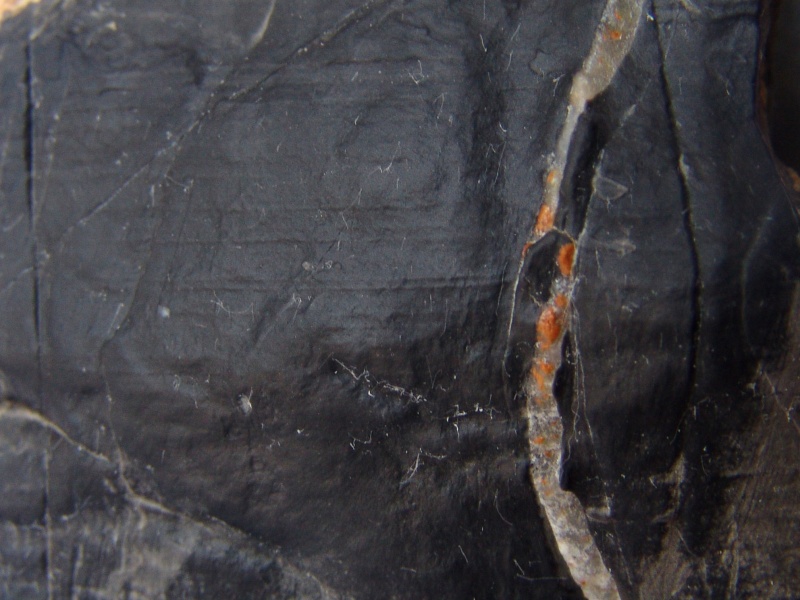
Pic#4 The 100% Acid bath for 15 seconds.
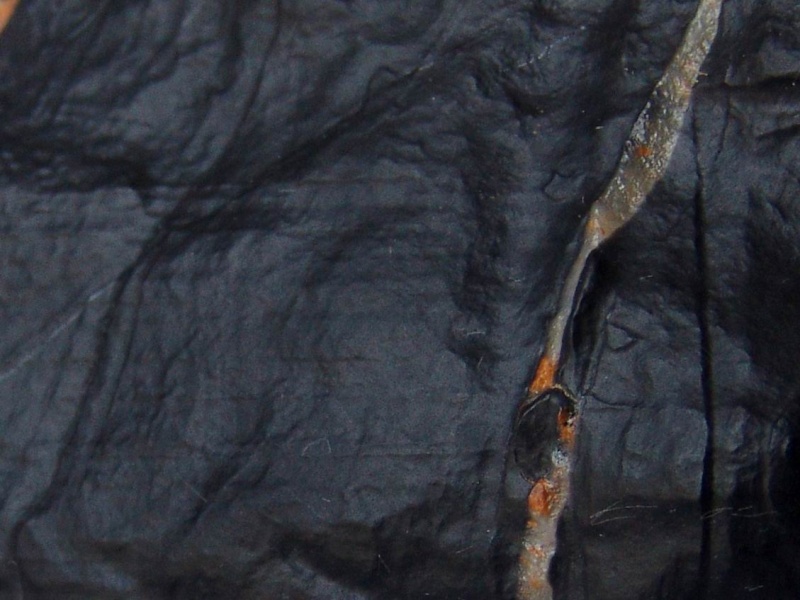
Pic#5 The 100% Acid bath for 300 seconds.

My loving for stone is based on my hometown is Lingbi County ,the other is my brother Mr Chong Wong ,an edit of "Lingbi Stone Newspaper",so,I come to love the stone collection.
I am woking in Ningbo ,but ,I have no connections with Shanghai or Ningbo Stone Association.As for the Ling Wen stone and resonant stones questions & its distribution,I will reply to you later .
This is the Lingbi stone processing ways for your kind reference ,my english is poor ,so,I am not sure if its descriptions are correct .
We treat the newly–digged Lingbi QinStone as the rusty iron ,first ,we have to make the surface treatment, according to the recordation of “yunlin shi pu”using iron tool to scrape it two to three times .we brush its surface evenly with steel bursh ,we will brush the stone accoring to its natural whorls when we brush them .After brushing ,The Lingsbi stone show itself as Cyan .Lingshi Stone disposed to this course,the mounting for stone should be available for its appreciation .
Through the change of the air temperature and humidity ,its surface colour come to darken with the time pass and its surface colour will be more smoothy with hands daut,this kind of continuous transformation on its stone surface is one of the unique characteristics of the Lingbi stone.
At present, they are many ways of processing its surface ,it is up to the collectors’favourite,we choose some the prevalent processing ways for its sharing.Some Sonte Collectors’are in pursuit of its nautral & original beauty , just washing its surface with water without surface processing,the others are go in for its perfect appearance ,through its surface burshing ,hard polishing and waxing on its surface,after the dry of the wax and then brushing it with soft cloth ,this processing is the very popular among Lingbi Stone Collection.The third is threatment with Acid .
In the beginning of 80’,it is also the beginning of Lingbi stone collection ,it is popular to bath the Lingbi Stone with Acid ,its aim to brush its marl out on its appearance and show its balck in itself.Owing to its hard to control the acid densityso,the many Lingbi Stones’ furrows & whorls were being destroried during its acid processing .
According to the question of Acid processing is good or not among the National Stone Collectors’,so,we make some tests to compare and analyze its test results ,first ,we take Lingbi stone to brush and appear its body and then bath it with 10% acid for 15 seconds,observing and finding there is no change on the fine furrows & whorls ,its colou bcomes black and surface is smoothy and then the 50% acid for 15 seconds , the fine furrows & whorls has no obviously change ,its colour is dark and very smoothy on its surface ,the last 100% acid for 15 seconds ,the fine furrows & whorls are being destroied and its surface shows knaggy and shine.
Hoping our test results will be better for you know Lingbi stone .
The Processing Ways with Photos
Pic# 1 The newly-digged Lingbi stone without washing & brushing .

Pic# 2 Brushing its surface evenly with steel bursh ,we will brush the stone accoring to its natural whorls when we brush them.

Pic# 3 The Newly-digged Lingbi Qin Stone without brushing.

Pic# 4 After Washing & Soft Cloth brushing Lingbi Stone .

Pic# 5 Brushing with Steel brush without waxing Lingbi stone .

Pic# 6 The Prevailing Processing way of Lingbi Qin Stone .

Acid Testing Results of Lingbi stone .
Pic#1 Without Acid Processing ,the Original Lingbi stone.

Pic#2 The 10% Acid bath for 15 seconds.

Pic#3 The 50% Acid bath for 15 seconds.

Pic#4 The 100% Acid bath for 15 seconds.

Pic#5 The 100% Acid bath for 300 seconds.

jackwk- Member
 Re: Chinese Lingbi stone Photos & culture introduction.
Re: Chinese Lingbi stone Photos & culture introduction.
Hi Jack... THANK YOU!
This is an extraordinary photo essay regarding surface treatment, and a wonderful explanation of options.
I can see the glossy surface of raised area of stones which have been scraped, brushed & waxed in your photos. Most often, I see Lingbi stones with uniformily glossy-black surfaces & bright white calcite inclusions. Are they likely to be stones that have received an acid bath followed by waxing and hard polishing?
Thank you, again, for very fine photos and descriptions. IBC browsers appreciate your generous contribution!
This is an extraordinary photo essay regarding surface treatment, and a wonderful explanation of options.
I can see the glossy surface of raised area of stones which have been scraped, brushed & waxed in your photos. Most often, I see Lingbi stones with uniformily glossy-black surfaces & bright white calcite inclusions. Are they likely to be stones that have received an acid bath followed by waxing and hard polishing?
Thank you, again, for very fine photos and descriptions. IBC browsers appreciate your generous contribution!

Chris Cochrane- Member
 Re: Chinese Lingbi stone Photos & culture introduction.
Re: Chinese Lingbi stone Photos & culture introduction.
[quote="jackwk"]
[In the beginning of 80’,it is also the beginning of Lingbi stone collection ,it is popular to bath the Lingbi Stone with Acid ,]
Hi Jack, This has been a very informative topic !! In the quote above are you saying that lingbi stone was not collected before the 80's or that this is when the acid use began?
I have a very old lingbi that's still encrusted with the hard clay in the back of the stone and you can also see remnants in front . It's daiza is very old in which the stone has been , I believe, glued. I know that the stone is unusual in it's depiction of a figure and I also see a black bird in the center. Have you seen other lingbi forms other than landscapes?
I attempted to attach an image but the server would not upload it . I'll resize the photo and try again.
Thank you again for the wonderful photos of acid results on lingbi!
Norma
[In the beginning of 80’,it is also the beginning of Lingbi stone collection ,it is popular to bath the Lingbi Stone with Acid ,]
Hi Jack, This has been a very informative topic !! In the quote above are you saying that lingbi stone was not collected before the 80's or that this is when the acid use began?
I have a very old lingbi that's still encrusted with the hard clay in the back of the stone and you can also see remnants in front . It's daiza is very old in which the stone has been , I believe, glued. I know that the stone is unusual in it's depiction of a figure and I also see a black bird in the center. Have you seen other lingbi forms other than landscapes?
I attempted to attach an image but the server would not upload it . I'll resize the photo and try again.
Thank you again for the wonderful photos of acid results on lingbi!
Norma

Norma- Member
 Lingshi Stone Dstribution .
Lingshi Stone Dstribution .
Hi, Norma,
The first recordation of Lingbi Qin stone is ZHANG GUO Period (403-221 A.D) in China ,Lingbi Qin stone as a musical instrument for music play,its name is "Bian Bell",in its history ,the collection of Lingbi stone was very prevailing in Song Dynasty and Ming Dynast and In Qing Dynast ,The Emperor of QianLong called its" No.1 Stone in the World.
In the beginning of 80’,it is also the beginning of Lingbi stone collection ,it means in the history of P.R.O C ,it is begin to the Lingbi stone collection and then the stone with acid bath .
Lingbi stone gives birth to Yugou town of Lingbi County, the center to the old Quarry of Song Dynast ,which is the original place of Lingbi stone ,it is about 10Km from North-East to South-West in length.
The specific location of Lingbi stone collection in Song Dynast is lying to the South-East of Zhengxiang Village of Yugou town,the west slope of Qin stone .Today ,in order to monumentalize “the Old Quarry of Song Dynast “,the People Government of Lingbi County set up a “Mounment of the Old Quarry of Song Dynast”in this place .According to the Zheng gang Village ‘center ,the Qin stone mountain chain stretches to the North-East ,To the west of Qin stone mountain chain ,the following villages which produce the Lingbi stone ,such as, Tushan village ,Shen zhai village ,Wang shan village ,Shang du village .To the east of Qin sotne mountain chain ,”the Xiao dian zi village , Shang tao village ,Lliang ji village ,Zhuan shang village “,They also manufacture the Lingbi stone .and then ,the Qin stone mountain chain stetches to the South-West ,the following villages who make the stone in turn are “the Zhuo tang village ,Malou Village, Zhou zhai Village,Bai ma Village”the above-mentioned villages’stone have the same texture as Qin stone and the local people call them as “Qin stone” ,the Lingbi Qin stone is famouse for its smoothy texture, dark colour ,pure resonant & variable shapes,it is the first choice of Lingbi stone.Even though ,those mentioned villages have the same texture ,but ,further reseraching ,you will find that the colours and its Whorls are different ,for example ,the Bai ma village who mainly produces the Lingbi Wen stone ,this can reply to Mr Chris’question “the Lingbi Wen stones come from a mountain in southern Anhui, but Lingbi Village with Qingshi Hill heritage is in the northern part of the province, I think.”The Bai ma village is the original place of Lingbi wen stone ,it comes from a mountain in souther of Qin stone mountain chain ,not in souther of Anhui.and the Zhou zhai village ,Malou village ,Zhuo tang village are famouse for its Super stone surface ,it is better for stone appreciation .The double colour of Black & Red in Zhenag gang Village ,the variable shapes in Shang shan village, Shen zhai village, Wang shan village,and the special Pear Wen stone is from Shang tao Village .those stones are in various charteristics,it is easy for Lingshi stone enthusiast to distinguish them by carefully observing .
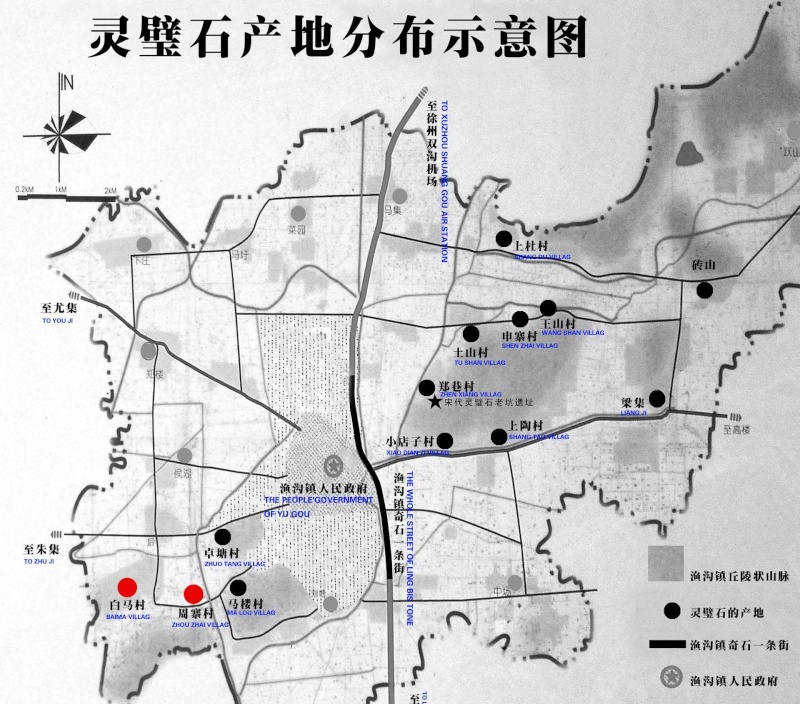
The first recordation of Lingbi Qin stone is ZHANG GUO Period (403-221 A.D) in China ,Lingbi Qin stone as a musical instrument for music play,its name is "Bian Bell",in its history ,the collection of Lingbi stone was very prevailing in Song Dynasty and Ming Dynast and In Qing Dynast ,The Emperor of QianLong called its" No.1 Stone in the World.
In the beginning of 80’,it is also the beginning of Lingbi stone collection ,it means in the history of P.R.O C ,it is begin to the Lingbi stone collection and then the stone with acid bath .
Lingbi stone gives birth to Yugou town of Lingbi County, the center to the old Quarry of Song Dynast ,which is the original place of Lingbi stone ,it is about 10Km from North-East to South-West in length.
The specific location of Lingbi stone collection in Song Dynast is lying to the South-East of Zhengxiang Village of Yugou town,the west slope of Qin stone .Today ,in order to monumentalize “the Old Quarry of Song Dynast “,the People Government of Lingbi County set up a “Mounment of the Old Quarry of Song Dynast”in this place .According to the Zheng gang Village ‘center ,the Qin stone mountain chain stretches to the North-East ,To the west of Qin stone mountain chain ,the following villages which produce the Lingbi stone ,such as, Tushan village ,Shen zhai village ,Wang shan village ,Shang du village .To the east of Qin sotne mountain chain ,”the Xiao dian zi village , Shang tao village ,Lliang ji village ,Zhuan shang village “,They also manufacture the Lingbi stone .and then ,the Qin stone mountain chain stetches to the South-West ,the following villages who make the stone in turn are “the Zhuo tang village ,Malou Village, Zhou zhai Village,Bai ma Village”the above-mentioned villages’stone have the same texture as Qin stone and the local people call them as “Qin stone” ,the Lingbi Qin stone is famouse for its smoothy texture, dark colour ,pure resonant & variable shapes,it is the first choice of Lingbi stone.Even though ,those mentioned villages have the same texture ,but ,further reseraching ,you will find that the colours and its Whorls are different ,for example ,the Bai ma village who mainly produces the Lingbi Wen stone ,this can reply to Mr Chris’question “the Lingbi Wen stones come from a mountain in southern Anhui, but Lingbi Village with Qingshi Hill heritage is in the northern part of the province, I think.”The Bai ma village is the original place of Lingbi wen stone ,it comes from a mountain in souther of Qin stone mountain chain ,not in souther of Anhui.and the Zhou zhai village ,Malou village ,Zhuo tang village are famouse for its Super stone surface ,it is better for stone appreciation .The double colour of Black & Red in Zhenag gang Village ,the variable shapes in Shang shan village, Shen zhai village, Wang shan village,and the special Pear Wen stone is from Shang tao Village .those stones are in various charteristics,it is easy for Lingshi stone enthusiast to distinguish them by carefully observing .

jackwk- Member
 Re: Chinese Lingbi stone Photos & culture introduction.
Re: Chinese Lingbi stone Photos & culture introduction.
Hi Norma,
Thanks for your sharing of your stone ,it looks like a vivid cartoon boy with a cap ,thinking and watching.
Yes ,it its Lingbi qin stone,it conforms to the following rules of Lingbi qin stone distinction,one is that there are some red & yellow clay attached to the stone bottom not glued.any way ,if you tap it ,the stone will make a resonant & ringing sound ,because ,the Lingbi Qin stone belongs to the limestone stone and its Mohs hardness is 6,so, the Lingbi Qin stone also called "Ba Yin Shi" ,whishing this will be helpful for you know Lingbi stone better.
Best Regards
Jack Wang
Thanks for your sharing of your stone ,it looks like a vivid cartoon boy with a cap ,thinking and watching.
Yes ,it its Lingbi qin stone,it conforms to the following rules of Lingbi qin stone distinction,one is that there are some red & yellow clay attached to the stone bottom not glued.any way ,if you tap it ,the stone will make a resonant & ringing sound ,because ,the Lingbi Qin stone belongs to the limestone stone and its Mohs hardness is 6,so, the Lingbi Qin stone also called "Ba Yin Shi" ,whishing this will be helpful for you know Lingbi stone better.
Best Regards
Jack Wang
jackwk- Member
 Re: Chinese Lingbi stone Photos & culture introduction.
Re: Chinese Lingbi stone Photos & culture introduction.
Thank you, Jack, for such comprehensive and clear information. The very accomplished knowledge which you share of Lingbi stones extends our appreciation.
Can you share similar details regarding 'White' Lingbi scholars' rocks? I am fascinated by your generous descriptions and photos.
Throughout the world, enthusiasts are particularly intrigued by stone from their own region. The IBC "Stone forum" is incredibly fortunate to have enthusiasts sharing appreciation of modern as well as traditional enthusiasm & practice.
Can you share Chinese terms used typically by enthusiasts in the Lingbi area for stones of traditional style (scholars rocks, gongshi, qishi et al.) or modern style (such as your natural 'Nefertiti' bust)? The Shanghai stone community has strongly supported shangshi as descriptive of modern stone collecting. Are different terms used for different purposes-- for example, one term used for describing a stone, another used typically for identifying a group of stone enthusiasts and, perhaps, a term for stones whose allusion which is not essentially Chinese or separate from traditional scholar-style appreciation?
Scholars' stone author Kemin Hu has suggested the name shizuo "stone seat" for describing the fitted wood stand crafted for a particular stone. Is shizuo universally accepted-- often we see Chinese publications translated into English with the Japanese suiseki term 'daiza' which seems awkward & diminishes uniqueness of Chinese "stone seat" style?
Norma had asked about Lingbi stones used as other than landscape forms. Of the five illustrations you provided, the "Egyptian queen's profile" & "warty toad" seemed to suggest other allusions. I would imagine the warty toad in traditional style might be recognized as a landscape form in the shape of a toad, which would deepen its appreciation of concentrating larger nature into qi/chi energy with trans-formative physical attributes (including concentrated landscape vastness & vivified animal/toad spirit).
I apologize in advance for asking so much. You've been so gracious, already. I hope to return to questions on stones and Chinese tea culture with you & other informative Chinese enthusiasts.
Can you share similar details regarding 'White' Lingbi scholars' rocks? I am fascinated by your generous descriptions and photos.
Throughout the world, enthusiasts are particularly intrigued by stone from their own region. The IBC "Stone forum" is incredibly fortunate to have enthusiasts sharing appreciation of modern as well as traditional enthusiasm & practice.
Can you share Chinese terms used typically by enthusiasts in the Lingbi area for stones of traditional style (scholars rocks, gongshi, qishi et al.) or modern style (such as your natural 'Nefertiti' bust)? The Shanghai stone community has strongly supported shangshi as descriptive of modern stone collecting. Are different terms used for different purposes-- for example, one term used for describing a stone, another used typically for identifying a group of stone enthusiasts and, perhaps, a term for stones whose allusion which is not essentially Chinese or separate from traditional scholar-style appreciation?
Scholars' stone author Kemin Hu has suggested the name shizuo "stone seat" for describing the fitted wood stand crafted for a particular stone. Is shizuo universally accepted-- often we see Chinese publications translated into English with the Japanese suiseki term 'daiza' which seems awkward & diminishes uniqueness of Chinese "stone seat" style?
Norma had asked about Lingbi stones used as other than landscape forms. Of the five illustrations you provided, the "Egyptian queen's profile" & "warty toad" seemed to suggest other allusions. I would imagine the warty toad in traditional style might be recognized as a landscape form in the shape of a toad, which would deepen its appreciation of concentrating larger nature into qi/chi energy with trans-formative physical attributes (including concentrated landscape vastness & vivified animal/toad spirit).
I apologize in advance for asking so much. You've been so gracious, already. I hope to return to questions on stones and Chinese tea culture with you & other informative Chinese enthusiasts.

Chris Cochrane- Member
 Re: Chinese Lingbi stone Photos & culture introduction.
Re: Chinese Lingbi stone Photos & culture introduction.
Hi Cris ,
It is my duty to share more Lingbi Stone & its culture with all the enthusiasts around the wrold.
With regards to the "White Lingbi Stone" ,here is description it, its texture is very fine ,white as jade.it is the polymer of calsite & white could cliff.The White Lingbi Stone has no more variable shapes , except for its smoothy skin & jade bone.Concerning its assortments ,White Lingbi Stone has red & white ,yellow & white ,gray & white,brown& white and black & white,the white fleckiness which like as snow ,white clounds , embeds on the stone body.
In Lingbi area,The enthusiasts typically use" Qishi " for traditional style ,because ,the meaning for "Qi" in english is rare and the other meaning for "Qi shi " is its shapes are variable and naturally formed ."Gongshi" meaning is a rare gift for Emperor ,In ancient China ,the materials from the local to the center ,for Emperor ,the means we call it as "Gong",so,the stone for Emperor ,we called its "Gongshi" .As the "Scholar rocks ",in ancient period ,Song ,Ming & Qing dynast ,the Poets,Official,Scholar or Collector ,who has a particular hobby for stone and formed a culture "Stone Culture"among them ,that is the name of "Scholar Stone".
The Shanghai stone community supports shanghai as its modern stone collecting ,as different terms with different purpose ,you are right .At the moment ,some stone communities are not just for appreciation ,but ,as well as business profits .
the name shizuo for "stone seat" is normally accepted by enthusiasts in China and I also note that the Chinese publications always translated "shizuo" into the Japanese suiseki term 'daiza' in English ,The meaning for Suiseki is water stone and its daiza is normally with sands ,the Suiseki with daiza is naturally integrated ,but ,,the Chinese "Shizuo " translated into "Daiza",it not only diminishes uniqueness of Chinese "stone seat" style but as well as causing the confusion on the cuture for the new collector.
Pls kindly refer to the follow pic of snake,you will find that the" Shizuo" matcheswith the stone snake very well ,,but if we use the term" Daiza" ,it seems more awkward .

It is my duty to share more Lingbi Stone & its culture with all the enthusiasts around the wrold.
With regards to the "White Lingbi Stone" ,here is description it, its texture is very fine ,white as jade.it is the polymer of calsite & white could cliff.The White Lingbi Stone has no more variable shapes , except for its smoothy skin & jade bone.Concerning its assortments ,White Lingbi Stone has red & white ,yellow & white ,gray & white,brown& white and black & white,the white fleckiness which like as snow ,white clounds , embeds on the stone body.
In Lingbi area,The enthusiasts typically use" Qishi " for traditional style ,because ,the meaning for "Qi" in english is rare and the other meaning for "Qi shi " is its shapes are variable and naturally formed ."Gongshi" meaning is a rare gift for Emperor ,In ancient China ,the materials from the local to the center ,for Emperor ,the means we call it as "Gong",so,the stone for Emperor ,we called its "Gongshi" .As the "Scholar rocks ",in ancient period ,Song ,Ming & Qing dynast ,the Poets,Official,Scholar or Collector ,who has a particular hobby for stone and formed a culture "Stone Culture"among them ,that is the name of "Scholar Stone".
The Shanghai stone community supports shanghai as its modern stone collecting ,as different terms with different purpose ,you are right .At the moment ,some stone communities are not just for appreciation ,but ,as well as business profits .
the name shizuo for "stone seat" is normally accepted by enthusiasts in China and I also note that the Chinese publications always translated "shizuo" into the Japanese suiseki term 'daiza' in English ,The meaning for Suiseki is water stone and its daiza is normally with sands ,the Suiseki with daiza is naturally integrated ,but ,,the Chinese "Shizuo " translated into "Daiza",it not only diminishes uniqueness of Chinese "stone seat" style but as well as causing the confusion on the cuture for the new collector.
Pls kindly refer to the follow pic of snake,you will find that the" Shizuo" matcheswith the stone snake very well ,,but if we use the term" Daiza" ,it seems more awkward .

jackwk- Member
 Re: Chinese Lingbi stone Photos & culture introduction.
Re: Chinese Lingbi stone Photos & culture introduction.
Hi Chris ,
I am sorry not to reply to you in time, because I was very busy in the past days .
As you mentioned warty toad, you and Miss Norma and you think it as landscape form in the shape of toad, which really can deepen its appreciation of concentrating larger nature into qi/chi energy, but, in China, there is a saying "Rui Shou" which means the Beast who can bring a good fortune and called "Resembling Stone".
Hi Mr Chris, as for the Chinese Tea culture, if you need some information, pls kindly let me know it, I will reply to all of your questions.
In your other topic, you mentioned the WUHU Iron Painting, It is one of the unique character of the China carftswork, but, I do not know it well, so, I cannot present more information with you now.
Here is White Lingbi Stone photo's for its appreciation.
3.Grey & White

4.Red & White
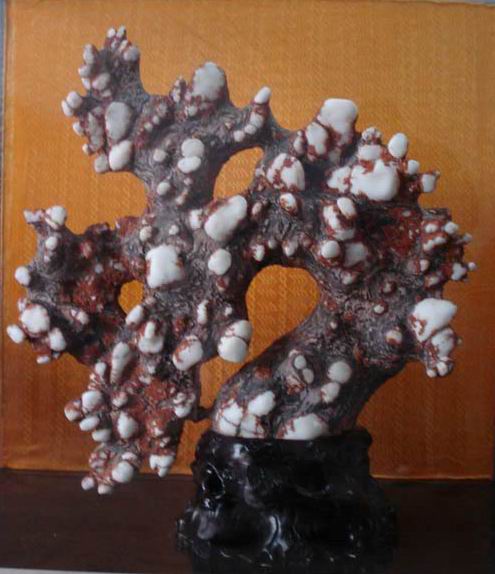
Hoping this will be good for you .
Best Regards
Jack
I am sorry not to reply to you in time, because I was very busy in the past days .
As you mentioned warty toad, you and Miss Norma and you think it as landscape form in the shape of toad, which really can deepen its appreciation of concentrating larger nature into qi/chi energy, but, in China, there is a saying "Rui Shou" which means the Beast who can bring a good fortune and called "Resembling Stone".
Hi Mr Chris, as for the Chinese Tea culture, if you need some information, pls kindly let me know it, I will reply to all of your questions.
In your other topic, you mentioned the WUHU Iron Painting, It is one of the unique character of the China carftswork, but, I do not know it well, so, I cannot present more information with you now.
Here is White Lingbi Stone photo's for its appreciation.
3.Grey & White

4.Red & White

Hoping this will be good for you .
Best Regards
Jack
Last edited by jackwk on Wed Aug 19, 2009 9:53 am; edited 1 time in total
jackwk- Member
 Lingbi Stone'distinguish & appreciation .
Lingbi Stone'distinguish & appreciation .
How to distinguish the truth or false of Lingbi Stone ,the three ways will be introduced as follows:
1.The first step is to see if the stone back or root ,(called stone bottom,)with the red & yellow gizzard adhered on it and also rigidity on stone surface ,not glued .Even ,some small stone' gizzard can be cleaned off ,but ,the stone root is atill in good condition .if all the above-mentioned factors are with the following two items ,the stone is truth of LIngbi stone .
2.The stone skin & its texture ,Lingbi stone skin is very smooth with strong hand sense("Shou, Zhou, Tou, Lou"which do not affect the stone skin smoothness .The stone muscle with the special grey & white grain ,the grain is naturally clear and fluency,its original grain shows the shape of "V",but ,the manual processing of stone grain appears the shape of "U"and its grain clour is not the natural. If whasing it ,the manualstone gain shows quickly and the water dry slowly ,but ,the original sonte drys quickly.
1.The first step is to see if the stone back or root ,(called stone bottom,)with the red & yellow gizzard adhered on it and also rigidity on stone surface ,not glued .Even ,some small stone' gizzard can be cleaned off ,but ,the stone root is atill in good condition .if all the above-mentioned factors are with the following two items ,the stone is truth of LIngbi stone .
2.The stone skin & its texture ,Lingbi stone skin is very smooth with strong hand sense("Shou, Zhou, Tou, Lou"which do not affect the stone skin smoothness .The stone muscle with the special grey & white grain ,the grain is naturally clear and fluency,its original grain shows the shape of "V",but ,the manual processing of stone grain appears the shape of "U"and its grain clour is not the natural. If whasing it ,the manualstone gain shows quickly and the water dry slowly ,but ,the original sonte drys quickly.
jackwk- Member
 Re: Chinese Lingbi stone Photos & culture introduction.
Re: Chinese Lingbi stone Photos & culture introduction.
Hi Jack... Your explanations are so clear. Thanks for your generous texts and photos in regard to Lingbi stone understanding. We eagerly await your next installment ("Step 3") for distinguishing genuine Lingbi stones. Perhaps you could clarify what you mean as "true or false" in regard to Lingbi by identifying one or more false stones.
In responding to Norma earlier in the thread (July 23), you noted:
I imagined the “ “double-color of Black & Red in Zheng gang Village” stone would be a dull in-color as we see in “Red Taihu” stones or in Kemin Hu's illustration (Modern Chinese Scholars Rocks, p.20) of a smooth Red Lingbi stone quarried from Jiuding Mountain in Lingbi County, but perhaps it is as bright and conspicuous as the red Lingbi stone shown in your August 25th post.
That bright red Lingbi with its dramatically piercing hole(s) has wrinkles normally associated with limestone rock textures. Is it limestone or another stone material? Is the White Lingbi with its smooth surface limestone as well as the encasing black or gray wrinkled stone?
You note of the bright-red Lingbi stone is now rare; can you share when it was commonly collected & where?
Thanks, Jack!!!!!
A very resonant Lingbi stone that I've never displayed was separated from its stand before I received it (1998). I did see a photo from China with the stone sitting in a low shizuo on its left side (when facing the stone) as illustrated. I thought missing the seat not so very important at the time, but since I haven't arranged a seat in over 10 years, I regret not pursuing the seat which was supposedly in-transit. Is the vertical alignment a good choice or did the earlier owner have a better idea? The stone is ~20" (50cm.) tall above its temporary seating and ~14" (35cm.) wide...
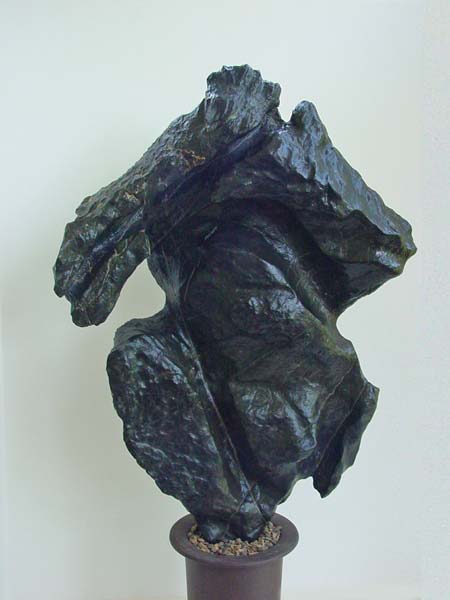 [i]
[i]
In responding to Norma earlier in the thread (July 23), you noted:
Can you share more by illustration of these differences? Your illustrating the subtle differences will help enthusiasts internationally and increase interest in observing the Lingbi stones’ variety.… Zhou zhai village, Malou village, Zhuo tang village are famous for its Super stone surface, it is better for stone appreciation. The double colour of Black & Red in Zhenag gang Village, the variable shapes in Shang shan village, Shen zhai village, Wang shan village,and the special Pear Wen stone is from Shang tao Village. those stones are in various characteristics, it is easy for Lingshi stone enthusiast to distinguish them by carefully observing.
I imagined the “ “double-color of Black & Red in Zheng gang Village” stone would be a dull in-color as we see in “Red Taihu” stones or in Kemin Hu's illustration (Modern Chinese Scholars Rocks, p.20) of a smooth Red Lingbi stone quarried from Jiuding Mountain in Lingbi County, but perhaps it is as bright and conspicuous as the red Lingbi stone shown in your August 25th post.
That bright red Lingbi with its dramatically piercing hole(s) has wrinkles normally associated with limestone rock textures. Is it limestone or another stone material? Is the White Lingbi with its smooth surface limestone as well as the encasing black or gray wrinkled stone?
You note of the bright-red Lingbi stone is now rare; can you share when it was commonly collected & where?
Thanks, Jack!!!!!
A very resonant Lingbi stone that I've never displayed was separated from its stand before I received it (1998). I did see a photo from China with the stone sitting in a low shizuo on its left side (when facing the stone) as illustrated. I thought missing the seat not so very important at the time, but since I haven't arranged a seat in over 10 years, I regret not pursuing the seat which was supposedly in-transit. Is the vertical alignment a good choice or did the earlier owner have a better idea? The stone is ~20" (50cm.) tall above its temporary seating and ~14" (35cm.) wide...
 [i]
[i]
Chris Cochrane- Member
 Similar topics
Similar topics» Lingbi Stone
» the Spring Festival visits Lingbi stone origin (continuous)
» Spring Festival Lingbi stone origin Tour ( Part 2)
» Potomac Viewing Stone Group-- Chinese stone preferences
» Egg-shaped Chinese stone & Japanese dai/daiza
» the Spring Festival visits Lingbi stone origin (continuous)
» Spring Festival Lingbi stone origin Tour ( Part 2)
» Potomac Viewing Stone Group-- Chinese stone preferences
» Egg-shaped Chinese stone & Japanese dai/daiza
Page 1 of 1
Permissions in this forum:
You cannot reply to topics in this forum




















